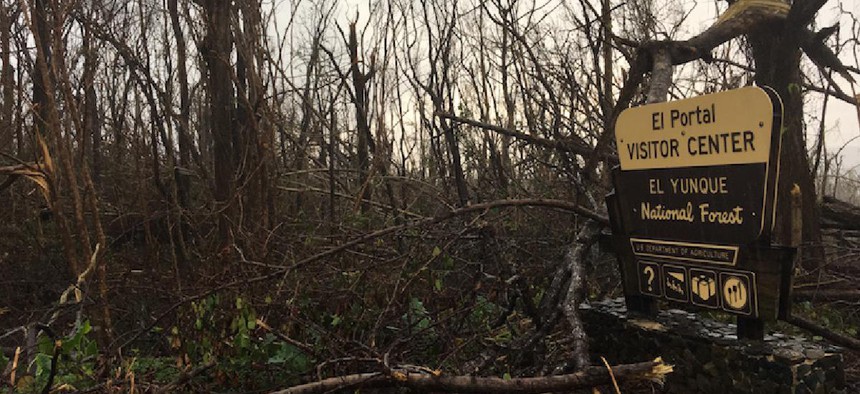For many, the image of Puerto Rico is a tropical paradise full of lush rainforests and pristine Caribbean beaches, rivers and waterfalls. But when Hurricane Maria hit the island in September, it transformed that reality overnight, and the environmental and ecological impact of the storm has yet to be fully evaluated a month and a half later.
“At the ecological level, the impact of Hurricane Maria has been quite devastating,” said Fernando Lloveras San Miguel, president of the nonprofit conservation organization Para la Naturaleza. “The fact that the hurricane crossed the island – east to west, north and south – had a very wide impact on all the ecosystems in Puerto Rico, from rain and dry forests to coastal and marine areas. There are numerous threats we have to respond to.”
RELATED: Cuomo: New York won't leave Puerto Rico behind
Para la Naturaleza is a 47-year-old organization that manages more than 30,000 acres of protected land on the island distributed among reserves, natural areas and conservation trusts. It also runs comprehensive environmental education programs throughout the island.
After the storm, it has focused on helping 60 communities that surround those natural areas by delivering food, fresh water and other supplies during the emergency phase. Once that humanitarian aid is completed, their efforts will concentrate on evaluating the damage to the flora and fauna and designing and implementing mitigation plans.
“The devastation of the flora is something we are very concerned about, which is why we are planning a wide-scale reforestation program as one of our key response actions after Maria,” Lloveras said. “For ecosystems to go from minimal to full, primary forest, it usually takes about 100 years. So you and I will not be seeing the forest the way we’ve seen it.”
That program will address two areas. The first area will deal with sustainable and agro-ecological farming, which has been severely impacted and has left an up-and-coming generation of conscious farmers in a precarious situation. The second will consist of a long-term reforestation initiative that will focus on planting native tree species.
RELATED: Native son: A Q&A with Assemblyman Marcos Crespo
To fund these efforts, the organization has launched a fundraising effort through the online Para la Naturaleza Community Fund, which so far has raised more than $180,000.
 “For ecosystems to go from minimal to full, primary forest, it usually takes about 100 years,” says Fernando Lloveras San Miguel, president of the nonprofit conservation organization Para la Naturaleza.
“For ecosystems to go from minimal to full, primary forest, it usually takes about 100 years,” says Fernando Lloveras San Miguel, president of the nonprofit conservation organization Para la Naturaleza.
“In terms of the vegetation, everything has been impacted, and it’s very frustrating to see that so little has been left standing, but we plan to engage our volunteers and go through our inventory of trees to determine what actions to take,” he said.
The recent reopening of the biweekly farmers market operated by the Madre Tierra Organic Cooperative demonstrated the need to help the community of young farmers who for years have struggled to produce pesticide-free crops, while the government has pushed to attract Monsanto, Bayer and all of the other multinational agro-sciences companies with attractive tax incentives and benefits not available to local producers.
At one of the small tables at the market, Abey Noriega displayed the few plants and crops he was able to rescue after Hurricane Maria destroyed his Campamento Guaraguao farm and his house in Naranjito.
“Our farms were totally blown away and we were left only with the food that grows underground,” says local farmer Abey Noriega.
“The eye of the hurricane passed through our town and it left our trees with no leaves, no shadow to give and all of the wooden houses and structures were destroyed,” Noriega said. “Our farms were totally blown away and we were left only with the food that grows underground. (The storm) even killed the animals, like chickens and cows.”
Based on his experience with previous storms, Noriega was able to save enough plants to restart his production again soon, “and the toughest job will be to rebuild our houses and the roads to access them.”
RELATED: Rep. Nydia Velazquez on providing for Puerto Rico
Mayra Nieves Rosa, president of the Madre Tierra Organic Cooperative, said that out of the 45 farmers and entrepreneurs that normally took part in the farmers market, only 15 were able to salvage products to sell, and many had lost their homes and farms.
“We have farmers that were able to save some part of their crops, and we decided to reopen the market with what we had because it is important for us to know that we can count on each other to start planting again and to work for a better Puerto Rico,” she said
More important than selling anything, she explained, was coming together again as a community to “share the hope that we will be back on our feet much sooner than people think.”
The farmers who work with herbs, spices and medicinal plants expect to have fresh crops ready by January, while those who work with fruits and coffee will need up to three years of harvest to begin selling products again. One of the advantages of sustainable farming is that it normally produces more than one crop, so when disasters like hurricanes hit, the farmers have options to move forward.
“It will depend on the coordination we are establishing and in getting a lot of help and support for our farmers, both ecological and traditional ones, which must be accomplished through collaboration and alliances we are establishing so that the people that are staying on the island to work hard remain positive and get the resources to stay and succeed,” Nieves Rosa said.
José E. Maldonado Marrero is editor of Periódico Soy Boricua, a digital newspaper based in Puerto Rico.


